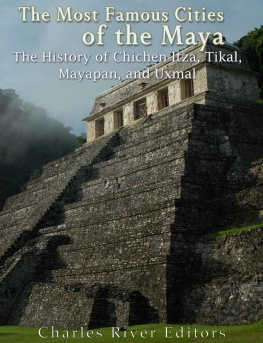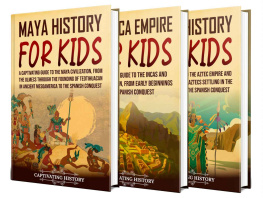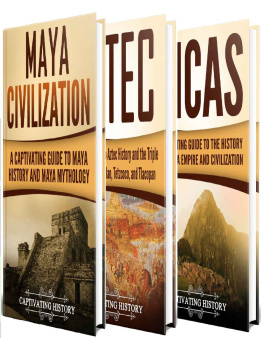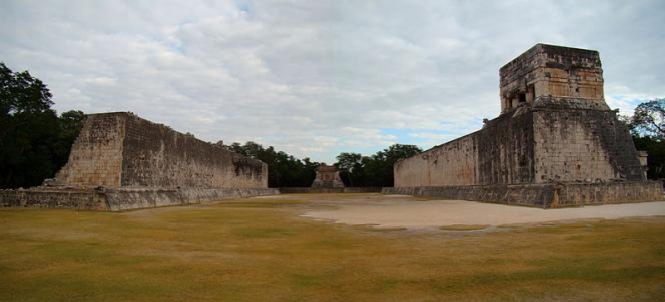Charles River Editors - The Most Famous Cities of the Maya: The History of Chichén Itzá, Tikal, Mayapán, and Uxmal
Here you can read online Charles River Editors - The Most Famous Cities of the Maya: The History of Chichén Itzá, Tikal, Mayapán, and Uxmal full text of the book (entire story) in english for free. Download pdf and epub, get meaning, cover and reviews about this ebook. year: 2016, publisher: Charles River Editors, genre: Science. Description of the work, (preface) as well as reviews are available. Best literature library LitArk.com created for fans of good reading and offers a wide selection of genres:
Romance novel
Science fiction
Adventure
Detective
Science
History
Home and family
Prose
Art
Politics
Computer
Non-fiction
Religion
Business
Children
Humor
Choose a favorite category and find really read worthwhile books. Enjoy immersion in the world of imagination, feel the emotions of the characters or learn something new for yourself, make an fascinating discovery.
- Book:The Most Famous Cities of the Maya: The History of Chichén Itzá, Tikal, Mayapán, and Uxmal
- Author:
- Publisher:Charles River Editors
- Genre:
- Year:2016
- Rating:3 / 5
- Favourites:Add to favourites
- Your mark:
The Most Famous Cities of the Maya: The History of Chichén Itzá, Tikal, Mayapán, and Uxmal: summary, description and annotation
We offer to read an annotation, description, summary or preface (depends on what the author of the book "The Most Famous Cities of the Maya: The History of Chichén Itzá, Tikal, Mayapán, and Uxmal" wrote himself). If you haven't found the necessary information about the book — write in the comments, we will try to find it.
*Describes the history and archaeology at each site
*Includes a bibliography for further reading
Many ancient civilizations have influenced and inspired people in the 21st century, like the Greeks and the Romans, but of all the worlds civilizations, none have intrigued people more than the Mayans, whose culture, astronomy, language, and mysterious disappearance all continue to captivate people. At the heart of the fascination is the most visited and the most spectacular of Late Classic Maya cities: Chichn Itz.
Chichn Itz was inhabited for hundreds of years and was a very influential center in the later years of Maya civilization. At its height, Chichn Itz may have had over 30,000 inhabitants, and with a spectacular pyramid, enormous ball court, observatory and several temples, the builders of this city exceeded even those at Uxmal in developing the use of columns and exterior relief decoration. Of particular interest at Chichn Itz is the sacred cenote, a sinkhole was a focus for Maya rituals around water. Because adequate supplies of water, which rarely collected on the surface of the limestone based Yucatan, were essential for adequate agricultural production, the Maya here considered it of primary importance. Underwater archaeology carried out in the cenote at Chichn Itz revealed that offerings to the Maya rain deity Chaac (which may have included people) were tossed into the sinkhole.
Early Mayapn was closely connected to the overshadowing power of the region at the time: the mighty trading city of Chichn Itz. Mayapn emerged first as a minor settlement in the orbit of Chichn, but it slowly came to replace it after the larger citys trade connections with the Toltecs of Tula crumbled and it suffered a staggering defeat by Mayapns armies. The building styles and art in their city show both admiring references to the great Chichn Itz as well as an attempt to position Mayapn as a more orthodox heir of Maya tradition. At the same time, they emulated many features and could not escape the tremendous influences - especially in religion - of Chichn. This is seen in the fact that many of the most important buildings in the new city appear to be small-scale reproductions of ones in Chichn.
The Maya maintained power in the Yucatan for over a thousand years, and at the height of its Classical era (3rd-9th centuries CE), the city of Tikal was one of the power centers of the empire. Archaeologists believe Tikal had been built as early as the 5th or 4th century BC, and eventually it became a political, economic and military capital that was an important part of a far-flung network across Mesoamerica, despite the fact it was seemingly conquered by Teotihuacan in the 4th century CE. It seems the foreign rulers came to assimilate Mayan culture, thus ensuring Tikal would continue to be a power base, and as a result, the city would not be abandoned until about the 10th century CE.
During the Mayas Classical era, the city of Uxmal was one of its most noteworthy places. While it was not as powerful as cities like Tikal, Uxmal was apparently at the forefront of Mayan culture, particularly when it came to architecture. However, while Uxmal used high ground to display its prominence, and the ruins are still among the most popular places for tourists in the region, the site is still shrouded in mystery. Even as scholars continue to work on the site to further interpret it, its still unclear when exactly Uxmal was founded, how many people called it home, and when it was abandoned, despite the existence of Mayan chronicles and oral legends. What is apparent, however, is the skills of Uxmals artisans, whether through constructing structures like the five-level Pyramid of Magicians and the expansive Governors Palace or adorning the structures with precisely detailed art and sculptures. In fact, the craftsmanship can be credited with helping to preserve Uxmal itself.
Charles River Editors: author's other books
Who wrote The Most Famous Cities of the Maya: The History of Chichén Itzá, Tikal, Mayapán, and Uxmal? Find out the surname, the name of the author of the book and a list of all author's works by series.




















